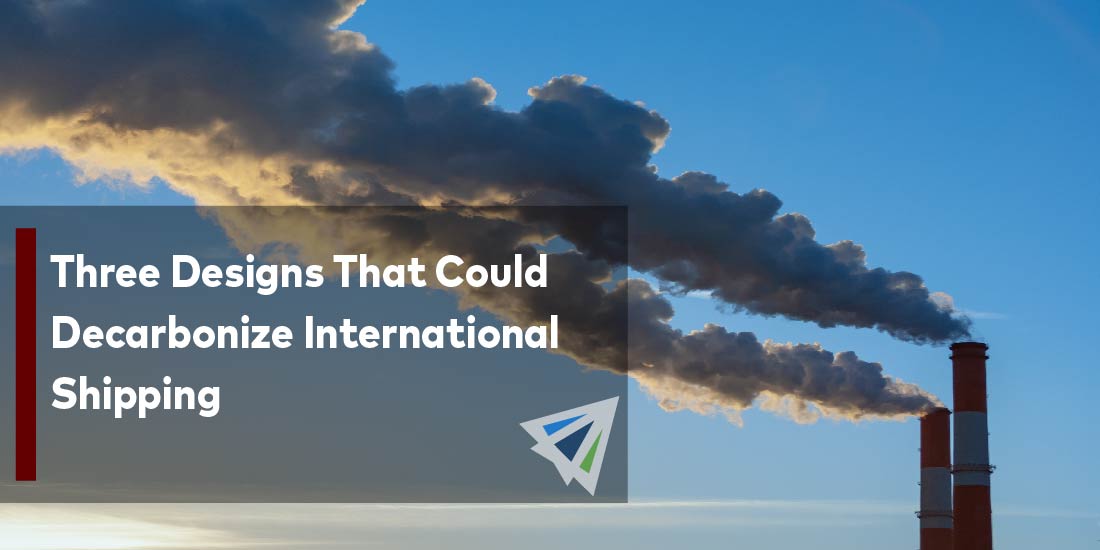Three Designs That Could Decarbonize International Shipping
Some things in logistics are straightforward. In order to ship cargo from one place to another, this movement requires a mode of transportation—whether that’s truck, rail, barge, plane, or ocean line.
Every day, countless carriers, shippers, and third parties make steadfast logistical decisions with each other over what mode, routing, and service will be used for their respective shipments.
Times this over a thousand and all of the sudden there’s a lot of traffic afoot. Trucks fill the highways, railcars roar across the countryside, and vast stretches of ocean are bridged by container ship lanes.
International trade spares no expense with its use of transportation. After all, it’s the exclusive mean of getting freight from one end of the globe to other.
Global shipping contributes to emissions
Though, a byproduct of the industry’s need for transportation is its contribution of greenhouse gas (GHG) emissions. Container ships alone account for estimated 3 percent of global GHG emissions.
That said, international shipping has been pressured to decarbonize by climate regulators and organizations. As a result, stakeholders, whether big or small, are jockeying for pursuit of green alternatives to traditional, and gas-reliant, container ships.
Though, what exactly could be a serviceable competitor to the proven, albeit gas-guzzling, performance of old-school cargo ships?
A lot of ideas are floating around, but here a few fascinating concepts to consider.
“Oceanbird”, Wallenius Marine
Spearheaded by Swedish shipping company Wallenius Marine, Oceanbird is the ethereal title to a cargo ship powered by retractable wing-like sails. The first vessel from this Oceanbird concept will be a roro (roll on roll off) carrier with the space to transport reportedly 7,000 cars.
As anything with the word bird in it would suggest, the vessel’s main energy force comes from wind. The wing sails have more in common with airplane wings than traditional sails which renders aerodynamics as important player in its design. The wing consists of a main sail and a flap, optimizing aerodynamic forces.
For example, if the graceful Oceanbird were to pass under a bridge when entering a harbor, the smaller segment folds into the other before the whole wing sail is tilted.
Wallenius reports its first vessel with this full-scale wing design will set sail in 2024.
“The Phenix Class”, Transport A La Voile
Developed by French company Transport A La Voile (TOWT), the Phenix Class concept of cargo ships is set to launch soon in June 2023.
Like the Oceanbird, the Phenix Class relies on wind force to deliver its promise of navigating the seven seas carbon-free. From its website, the Phenix Class may decarbonize up to 90 percent per ton per kilometer compared to a traditional containership.
From a capacity standpoint, the sail-powered vessel is slotted to hold 1,100 tons of freight. For reference, a “conventional” container ship (as defined by TWOT) carries 38,000 tons.
When considering transit time, the Phenix Class is projected to reach New York from Le Havre (a seaport on France’s northwest coast) in 13 days. While theoretical at this time, that transit would be competitive in today’s industry.
“SeaWing”, AirSeas
The SeaWing is not a concept for a ship. It’s actually just a kite.
But, don’t let that fool you. Its designer, Airseas, reports the formidable kite leads to a 20 percent decrease in GHG emissions. And, unlike the other two designs, the SeaWing has already been used for transatlantic service.
The allure to this kite sail is how it can be used by virtually any vessel in the market right now. Complimented with an automated flight control system, the Seawing essentially tows the vessel its equipped to forward. Like the Phenix Class or Oceanbird, the kite is able to pull off this feat by the magic powers of wind.
The kite flies at around 650 feet above the vessel and its operations are guided by advanced automation. The draw with this technology is that its tangible as we speak. In fact, a Japanese shipping company has already purchased 50 of these automated kites for over the next 20 years.
Is the future sail?
From the few designs above, a certain trend can be observed. They are all based around using some sort of sail technology.
By all accounts, sailing is age-old. Long before fuel-powered ships, sailing vessels connected the world’s commerce, even over ancient seas. Egyptians built ships as early has 3000 BCE to import goods from Lebanon and Punt.
These modern-day solutions are inspired off a relatively simple concept, yet are optimized with today’s capacity for high-tech.
As cutting-edge and innovative these designs are, these alternatives could have slower transit times compared to traditional and gas-dependent container ships.
Will shippers buy into the idea that a slightly slower delivery time but greener practice is worthy enough as a tradeoff?
Going Forward
As our imaginations run wild on what the future of maritime shipping could look like, certain standards cannot be ignored. Safety, functionality, crew comfort, and speed of transit, are all critical prerequisites for evolving a concept into a viable alternative.
Please contact our team if you’d like more information on this topic or any others in international shipping. In addition, check out our weekly market updates to stay informed on the latest in our industry.
